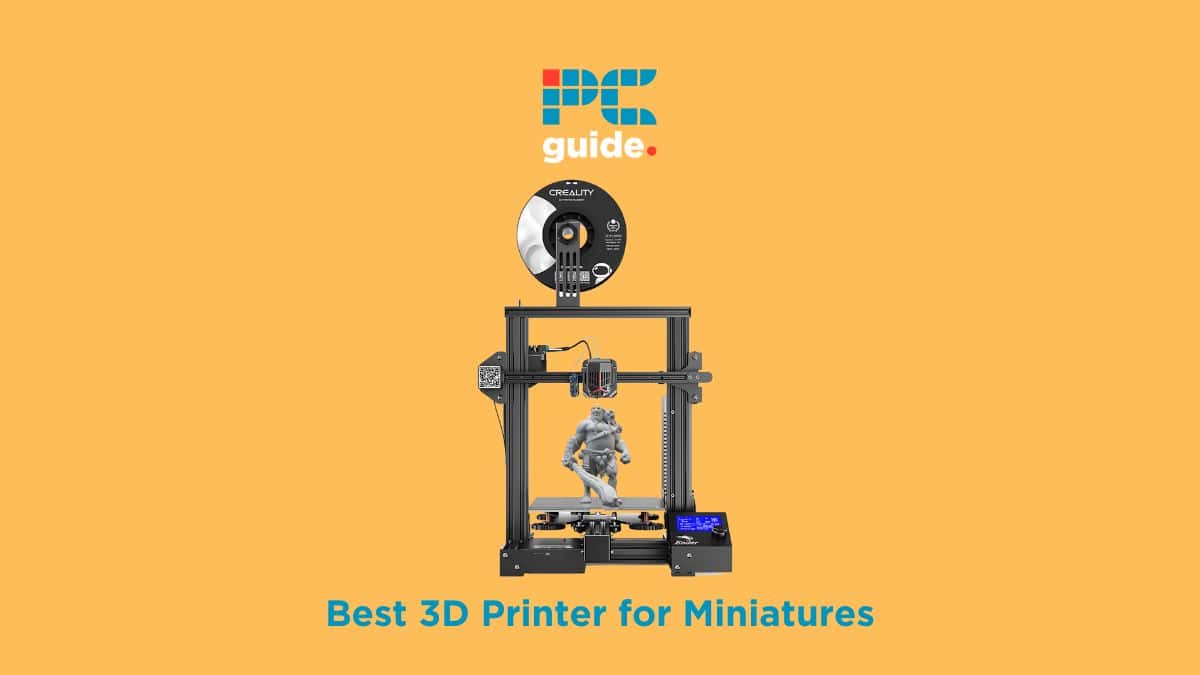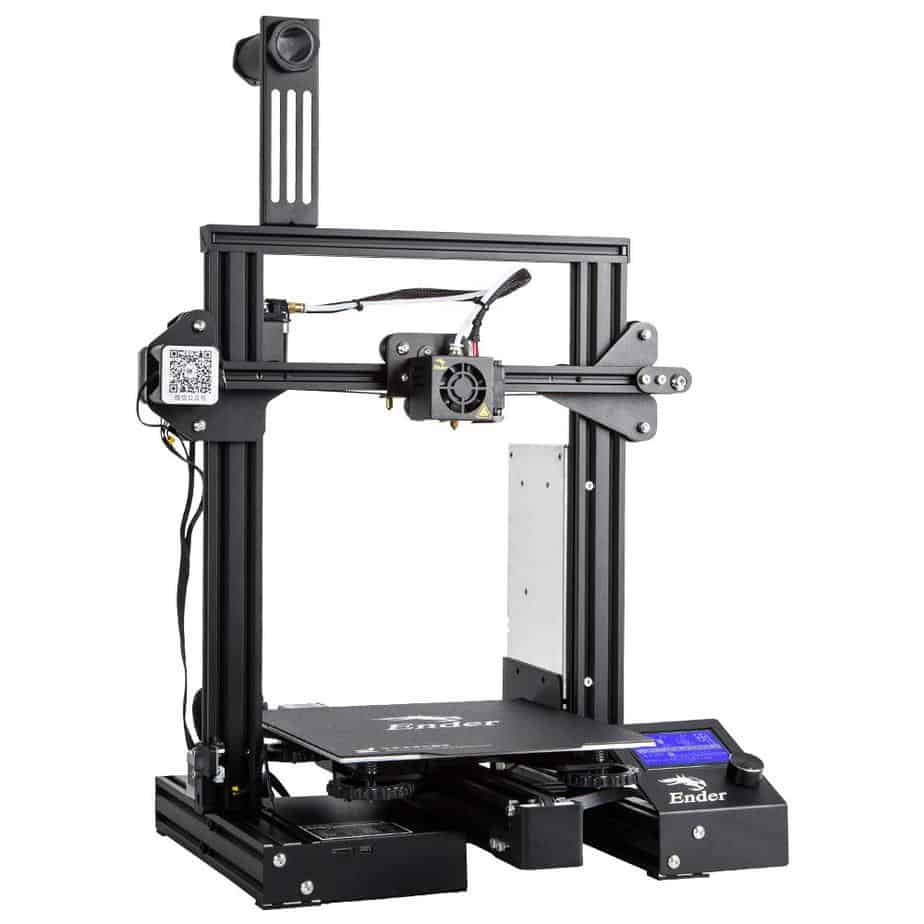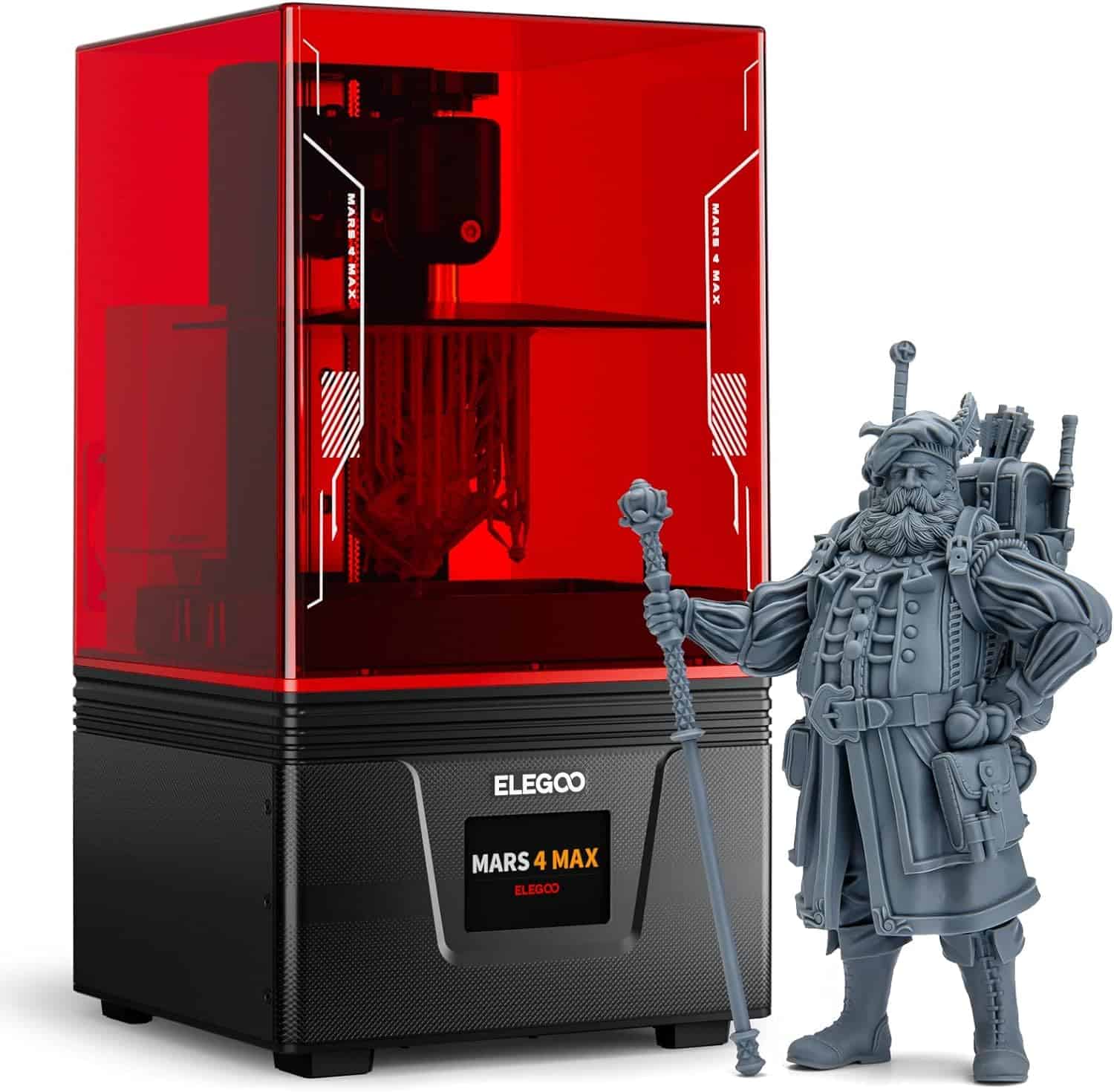Best 3D Printer for Miniatures 2024: Resin & SLA Printers for D&D

Table of Contents
If you’re tired of paying over the odds for new figures, why not print them yourself with the best 3D printer for miniatures? In recent years, the 3D printer industry has skyrocketed in popularity with plenty of low-cost options on the market. This makes them great vectors for homespun miniature print houses, to create detailed and high-quality figures for D&D, Warhammer, or any other game with custom figurines or components.
We’ve compiled a list of the best 3D printers for miniatures, across a range of prices and material compatibilities, so that Dungeon Masters or Board Game enthusiasts of any skill level or budget can begin crafting new characters today. Read on for our recommendations, and to find the best 3D printer for you!
-
Editor’s Pick
Creality Ender 3 Neo
- Build Volume: 300mm x 300mm x 320mm
- Filament: PLA, ABS, PETG, Wood, Nylon, Carbon Fiber
- Connectivity Technology: USB
- Filetype: STL, OBJ, AMF
-
Best Resin 3D Printer for Miniatures
ELEGOO Mars 4 Max MSLA 3D Printer
- Build Volume: 195mm x 122mm x 150mm
- Filament: SLA
- Connectivity Technology: USB
- Filetype: STL
-
Best Budget 3D Printer for Miniatures
Entina Tina 2 Mini
- Build Volume: 100mm x 120mm x 100mm
- Filament: PLA, TPU
- Connectivity Technology: USB
- Filetype: STL
-
Best Multipurpose 3D Printer for Miniatures
Snapmaker A350T
- Build Volume: 320mm x 330mm x 350mm
- Filament: PLA, ABS, PETG, TPU
- Connectivity Technology: WiFi
- Filetype: STL, OBJ
-
Best IDEX 3D Printer for Miniatures
Geeetech Mizar M
- Build Volume: 255mm x 255mm x 260mm
- Filament: PLA, ABS, PETG
- Connectivity Technology: SD
- Filetype: STL, GCode
How We Picked the Best 3D Printer for Miniatures
Though 3D printing may seem like a complex, multifaceted skill to learn; there are plenty of great models for beginners or Game Masters who just want to print. We first considered the standard array of core 3D printer features: assessing print quality and speed as well as build volume – though it’s unlikely that you’ll need one of the largest 3D printers, no matter how ambitious your miniatures.
For accessibility and versatility, we looked at 3D printers with easy-to-comprehend instructions and automated assistance for some of the more involved parts of 3D printing; along with models that were compatible with a range of different filament options. Finally, we considered an array of different price points, from premium models down to budget 3D printers, so that game enthusiasts aren’t alienated by the price tag.
We settled on five products, each with their own respective merits, but each with a claim to the title of “best 3D printer for miniatures”. We’ve broken down why each has advantages over the others, but equally where a 3D printer may have a disadvantage…

- Build Volume: 300mm x 300mm x 320mm
- Filament: PLA, ABS, PETG, Wood, Nylon, Carbon Fiber
- Connectivity Technology: USB
- Filetype: STL, OBJ, AMF
The Ender 3 Neo is ideal for those who want to learn as they build, being both beginner-friendly and versatile for seasoned 3D print enthusiasts – so you can print miniatures no matter your skill level.
- Excellent print quality – especially for this price point, the Ender 3 Neo's prints are rendered in excellent detail.
- Great build – with an aluminum frame, this 3D printer is sturdy and robust.
- Poor print bed adhesion – you risk damaging your miniatures just by attempting to retrieve them.
User-friendly, high-quality and low-cost: the Creality Ender 3 Neo is our choice for the best 3D printer for miniatures! Boasting a ton of great features that make it both accessible and versatile, this Creality 3D printer is a brilliant choice for Dungeon Masters or Game Masters of any skill level.
With great quality-of-life features such as auto-leveling and power outage protection, this 3D printer makes so many aspects of 3D printing easier on newcomers. Prints are created quickly and quietly with a highly efficient single-extruder in an open frame. Compact yet durable thanks to its aluminum build, this printer is a tremendously high-quality model – and with a price that hovers under $300 most of the time, it's a low cost to you.
But if you find that you struggle to remove your miniatures once complete, you're not alone. Many users have reported that the print bed adhesion on the Ender 3 Neo is inconsistent, and can result in difficulty or even damage to the prints when removed. It's this unit's only flaw, however, and it remains a top 3D printer for miniatures!

- Build Volume: 195mm x 122mm x 150mm
- Filament: SLA
- Connectivity Technology: USB
- Filetype: STL
SLA printing is a common alternative to traditional FDM printing miniatures, and the Mars 4 Max is the best-in-show in that category.
- High-quality prints – the Mars 4 Max renders miniature prints with great detail without sacrificing speed.
- Easy assembly – setting up this SLA printer is quick and easy.
- Resin only – unlike FDM printers, you are limited to creating your miniatures in only one material.
SLA printers, also known as Resin 3D printers, are a highly popular means of creating detailed models via a unique process: using lasers to carve a shape from a light-sensitive thermoset polymer. Our top pick in this category, the Elegoo Mars 4 Max, is our favorite offering – creating superb miniatures quickly and efficiently.
With an easy and minimal assembly process, you'll have the Mars 4 Max up and running in no time. Configure your settingly easily thanks to a helpful 4K touchscreen, and choose from a selection of print presets. No matter the design, the Mars 4 Max employs dual z-axis rails to quickly change laser direction to ensure fast and accurate prints. The resulting resin models are astonishingly accurate – and with a build volume of 195mm x 122mm x 150mm, you've got the freedom to create some terrific characters and props.
If we had to pick a flaw in the Mars 4 Max, it would be the lack of variety in options: whilst traditional FDM 3D printers can utilize a range of materials, SLA printers can only use resin. Though this is a limiting factor, it makes it an ideal solution for quick and intricate miniatures, and we still highly recommend the Mars 4 Max!

- Build Volume: 100mm x 120mm x 100mm
- Filament: PLA, TPU
- Connectivity Technology: USB
- Filetype: STL
If you can’t afford a full-fledged 3D printer for miniatures, how about a bite-sized version? The Tina 2 Mini saves on both space and money.
- Affordable – the low cost of the Tina 2 Mini is a serious draw.
- Great print quality – the productivity of the Tina 2 Mini is concentrated in such a small unit.
- Limited build volume – that concentrated quality is limited to 100mm x 120mm x 100mm, however.
Putting the “mini” in “miniatures”, the Entina Tina 2 Mini is a highly compact and affordable 3D printer for those with a budget under $200. This unassuming unit is easy to store and use, with 3D print models rendered quickly and easily when in use.
This small, enclosed 3D printer is ready practically out of the box: almost plug-and-play in design. Once you've configured your design with the packaged slicer software, the Tina 2 Mini get's to work rendering your design before your eyes. The user-friendly and small-scale nature of this makes it a great 3D printer for kids – creating miniatures of their favorite characters in no time.
However, the compact nature of this 3D printer does place a limit on your creativity: at 100mm x 120mm x 100mm, you may struggle to match your ambitions for the next campaign. No budget 3D printer is immaculate, though, and we still recommend the Tina 2 Mini as a great option for miniatures.

- Build Volume: 320mm x 330mm x 350mm
- Filament: PLA, ABS, PETG, TPU
- Connectivity Technology: WiFi
- Filetype: STL, OBJ
For the ultimate 3D printing, CNC carving and laser engraving solution rolled into one device; consider the A350T.
- 3-in-1 unit – boasting laser engraving and CNC carving as well as 3D printing, this is a highly versatile 3D printer.
- Smart features – near every element of printing is automated thanks to the A350T’s intelligent, user-friendly design.
- High price point – note that you’ll be paying the price of three devices in one.
As we mentioned when breaking down the best 3D printers for cosplay, the Snapmaker A350T is a beastly purchase for creative character design. A 3-in-1 CNC carver, laser engraver and 3D printer; this is a premium productivity powerhouse – almost overkill for miniatures.
Boasting a build volume of 320mm x 350mm x 330mm, you've got ample room to create your designs in a variety of formats, and with incredible precision. Thanks to an intelligent algorithm, the A350T actively adjusts and compensates to utterly minimize errors. Print using a variety of filaments, from PLA to ABS, and thanks to a gamut of automated features, avoid having to interfere with this highly versatile craft tool.
Given that you're effectively buying 3 premium units, you can expect a premium price tag attached to the A350T – which may not be ideal if your D&D party only meets infrequently. However, for unmatched value for money, this premium 3D printer for miniatures is the ideal solution!

- Build Volume: 255mm x 255mm x 260mm
- Filament: PLA, ABS, PETG
- Connectivity Technology: SD
- Filetype: STL, GCode
For multiple or multicolored miniatures, the Mizar M is a masterful choice.
- Gradient mixing – along with standard block colors, the Mizar M can seamlessly blend prints together for a stylish 3D print.
- Intuitive design – with automated leveling and intelligent configuration options, the Mizar M is great for beginners and veterans alike.
- Smaller build volume – whilst 260mm x 260mm x 260mm shouldn’t be dismissed out of hand, it does limit the creative scope of your miniatures.
The Geeetech Mizar M is a tremendous addition to any DM's arsenal, boasting quick and efficient 3D printing of miniatures thanks to an intelligent dual extruder system for high-speed and high-quality results.
A dual extruder effectively allows double the productivity of your 3D printer: print two models at once, or in multiple colors. The Mizar M allows you to blend colors naturally in a gradient or allocate block segments to be independently extruded. The 3D printer also allows for both automatic leveling for beginners, or manual configuration for the more experienced 3D printer user. With a build volume of 255mm x 255mm x 260mm, you've got plenty of room to create miniatures of any variety or complexity!
So why isn't this the best 3D printer for miniatures? Though speed isn't crucial to a 3D printer's success, the Mizar M is notably slower than other 3D printers of the same ilk – especially when blending in Gradient Mode. Though it stops the Mizar M from topping the list, it deserves a spot as one of the best 3D printers for miniatures!
Features and Considerations
If you’re looking at a different 3D printer with which to print your miniatures, here are some key factors to consider:
Compatibility
3D printers employ a software called a “slicer” that helps translate CAD designs into 3D print schematics, that are compatible with a range of different standard software drivers. If you’re using a character creator such as Hero Forge – which enables you to create STL CAD files out of your templates, make sure that your slicer software is capable of reading them. Do likewise for whatever other design software you prefer to use.
Filament
Miniatures can be made from a number of different materials, and 3D printers are able to print using most of them. PLA is the standard thermopolymer used by most FDM printers, but materials can range from PETG, carbon fiber, wood and nylon. Depending on your preferred style and budget, consider a 3D printer with more or less filament options.
Resolution
Most 3D printers are accurate to a degree measured in fractions of a millimeter or “microns”, but for miniatures this accuracy is even more important. Consider the general size of your planned miniature, and factor that in relation to the 3D printer’s listed resolution.
Price
Beyond the additional cost of the 3D printer – which can be as high as $2000 – there are ongoing costs to using it. The cost of filament, subscription rates for any design software… the energy bill additions from running the unit. Make an assessment based on your means, especially if you plan on printing a number of miniatures.
What is the Best 3D Printer Filament for Miniatures?
It is very much a subjective art determining the best 3D printer filament for miniatures, with each having its own respective merits and demerits. There are some headliners, however, for good reason:
ABS is one of the most popular polymer-based 3D print filaments for miniatures, being durable and resistant to the elements – including stray dice rolls. However, it requires higher temperatures than average 3D print materials, so is often substituted for PETG or PLA for those working on a budget.
Resin, as mentioned, is another highly popular option, for durable and accurate prints. Resin miniatures are also easier to shape and add detail to, but of course require a dedicated SLA printer.
Metal is a premium option: casting terrific 3D models from gleaming metal for a weighty and high-quality finish. It is the most expensive option, however, and requires incredible care and specialist technology to get right.
It’s worth noting that you can combine the various strengths of different materials to create the very best miniatures: use a resin baseplate, an ABS design and finish it with metal detailing, for example. Depending on what filaments you have available, experiment with putting them together – printing piecemeal and assembling.
FAQs
With such a wide library of pre-rendered components to choose from, HeroForge miniatures allow for a wide range of customization across a broad spectrum of styles and genres. However, whilst the digital tool is free to use, ordering the physical models themselves can be expensive. Thankfully, they allow you to download your designs as STL files, to use with your own 3D printer for miniatures.
Depending on the manufacturer and line of miniatures, they can be made from a number of different materials such as ABS, resin, PETG or metal. Most 3D printer filaments are suitable for use as miniatures, though each has their own respective advantages and disadvantages.
Verdict

- Build Volume: 300mm x 300mm x 320mm
- Filament: PLA, ABS, PETG, Wood, Nylon, Carbon Fiber
- Connectivity Technology: USB
- Filetype: STL, OBJ, AMF
Though you may have trouble retrieving them, the Creality Ender 3 Neo is the best 3D printer for miniatures currently on the market. A terrific median of price, quality and compatibility; this unit will see you through campaign after campaign, and help you improve your 3D printing skills alongside it!
If you’re business-minded with your 3D printing skills, why not consider investing in the best 3D printer for small businesses, to profit from your custom 3D designs?
